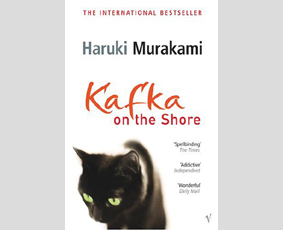To begin with a major annoyance, the English translation by Prof. Philip Gabriel of Murakami Haruki’s Kafka on the Shore1 has been excessively “britishized” for the first Vintage paperback edition.
The result is a weird mixture of American syntax and style with British spelling, typography, and vocabulary (mobile phones, lorries, and torches abound). Alas, this mixture isn’t just weird and off-putting: it’s effectively out-pulling insofar as the translation’s constant flow of linguistic inconsistencies pulls you right out of the story, time and again. It’s a great example of what I’ve come to call the Transparency With Birds effect. Meanwhile, Vintage also issued Gabriel’s original translation in a “reprint” paperback edition, so both that and the original hardcover edition are an option.
The story itself can wrap you up & take you away, but Kafka on the Shore is certainly not among Haruki’s masterpieces. The story lines are excessively opaque and excessively predictable at the same time, the characters at once over- and underdeveloped, and the novel has a Stephen King-ish feeling about it (certain motifs, characters, modes of progression), but without King’s knack for weaving even the most outlandish storylines into a gripping and satisfying solution. Not that Kafka on the Shore needed a solution, but it also lacks internal coherence. In the end, too many things and events have not been accounted for, neither in terms of a solution nor in terms of coherence. And certainly not in terms of development: especially Kafka Tamura, the principal character with first-person view (mostly), seems to have ended up right where he started, up to and including his fully intact alter ego that goes by the name of “Crow.”
The story’s development, like the characters’, is designed to be labyrinthine—a recurrent motif—rather than linear. Only, it’s more circular than labyrinthine, on balance. While both the phrases “wrong turns must be righted” and “wrong turns have been righted” turn up sufficiently often in the original paperback edition’s 615 pages to suggest one must have missed some major plot point or other, it is close to impossible even after attempts at backtracking to pinpoint what wrong turns have been taken when by which characters, let alone righted. That’s postmodern, alright. Speaking of which, there’s also that typically postmodern mix of ancient archetypes and corporate conspiracy elements, complete with a more than decent load of learned detours into art & culture, but without the tightly controlled over-the-top playfulness of, like, John Barth’s or Donald Barthelme’s or Robert Coover’s fiction. Plus, Murakami’s use of feminist characters and corporate icons feels forced, heavy-handed, and artificial. At times, the heavy-handedness even affects his writing technique: the way two pseudo-feminist cardboard characters “function” to reveal important attributes of another important character’s make-up (Oshima) borders on hack work.
But still, Kafka on the Shore is a rich and gripping reading experience. It does expand one’s understanding of the world, or at least one’s repertoire of questions. But of weaknesses, alas, it has more than its fair share.
If you have something valuable to add or some interesting point to discuss, I’ll be looking forward to meeting you at Mastodon!

